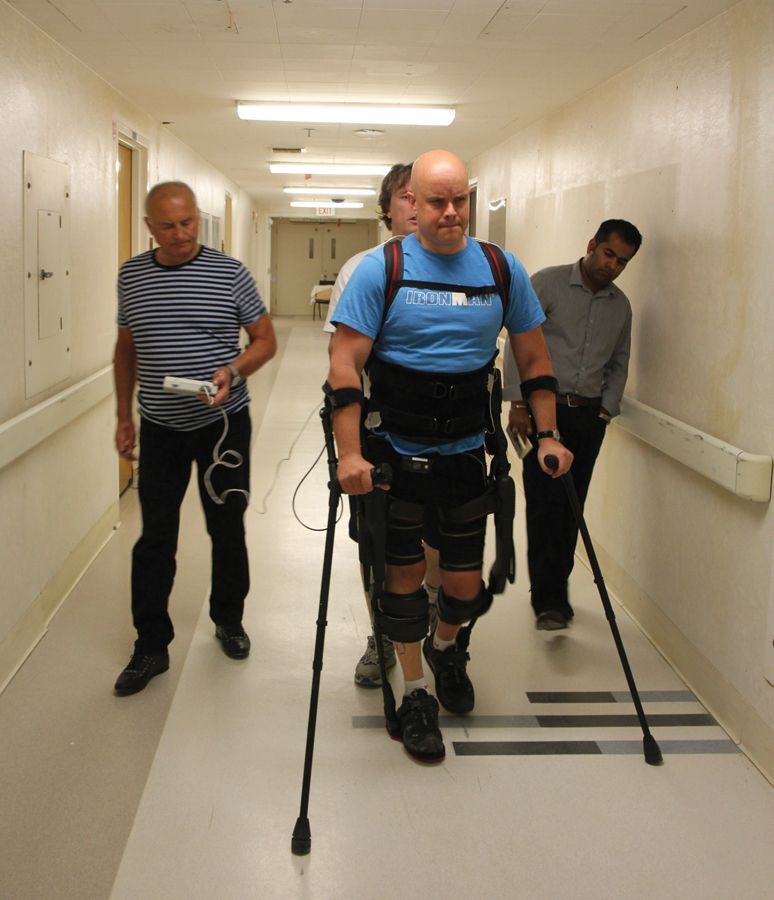Working with a team of UCLAscientists, a man with protracted and complete paralysis has recovered sufficientvoluntary control to take charge of a bionic exoskeleton and take manythousands of steps. Using a non-invasive spinal stimulation system thatrequires no surgery, this is claimed to be the first time that a person withsuch a comprehensive disability has been able to actively and voluntarily walkwith such a device.
Leveraging on research where the UCLA team recently used the same non-invasivetechnique to enable five completely paralyzed men to move their legs, the newwork has allowed the latest subject, Mark Pollock, to regain some voluntarymovement – even up to two weeks after training with the external electrical stimulation had ended.
Pollock, whohad been totally paralyzed from the waist down for four years prior to thisstudy, was given five days of training in the robot exoskeleton, and afurther two weeks muscle training with the external stimulation unit. Thestimulated and voluntary leg movements have not only shown that regaining mobility through this technique is possible, but that the training itself provides a rangeof health benefits in itself, especially in enhanced cardiovascular functionand improved muscle tone.

The new system has beencreated as an amalgam of a battery-driven bionic exoskeleton that allows users' leg movements to propel the unit in a step-by-step way, and a non-invasive externalstimulator to trigger nerve signals to create the leg movements. In this way, Pollock made significant progress after being given just a few weeks physicaltraining without spinal stimulation and then five days of spinal stimulation exercisean hour a day over a week-long period.
"In the last few weeks ofthe trial, my heart rate hit 138 beats per minute," said Pollock. "This is anaerobic training zone, a rate I haven’t even come close to since beingparalyzed while walking in the robot alone, without these interventions. Thatwas a very exciting, emotional moment for me, having spent my whole adult lifebefore breaking my back as an athlete."
Pollock has been a paraplegic since 2010 when he fell from a second-story window and suffered a spinal cord injury. Prior to that, after he lost his sight in 1998, he had been competing in ultra-endurance races through deserts, across mountains, and over the polar ice caps. He has even won medals in rowing at the Commonwealth Games for rowing. This will to win was evident in his use of the new device.
"Stepping with the stimulation and having my heart rate increase, along with the awareness of my legs under me, was addictive. I wanted more," Pollock said.

Using a commercial robotic device manufactured by Ekso Bionics for the trial, the system also captures and recordsdata to ascertain how much the participant isvoluntarily moving their limbs and compares that to the amount of help being provided by the device itself.
"If the robot does all the work, the subject becomes passive and the nervous system shuts down," said professor V. Reggie Edgerton, neurobiology and neurosurgery expert at UCLA, and lead author of the research.
In this case, the data demonstrated that Pollock was actually flexing his left knee and raising his left leg voluntarily. Both of which continued during and after the electrical stimulation, thereby proving that he was able to actively assist the robotic exoskeleton during walking rather than the device doing all the work.
"For people who are severely injured but not completely paralyzed,there’s every reason to believe that they will have the opportunity to usethese types of interventions to further improve their level of function," said professor Edgerton. "They’re likely to improve even more. We need toexpand the clinical toolbox available for people with spinal cord injury andother diseases. It will be difficult to get people with complete paralysis towalk completely independently, but even if they don’t accomplish that, the factthey can assist themselves in walking will greatly improve their overall healthand quality of life."
The results of this research were recently published and presentedat the 37th Annual International Conference of the IEEE Engineering in Medicineand Biology Society.
The short video below shows the UCLA exoskeleton and Mark Pollock in action.
Source: UCLA








